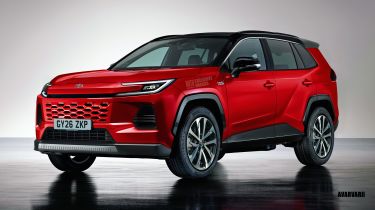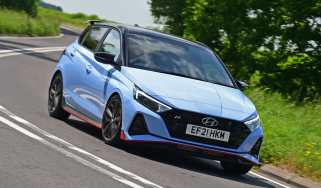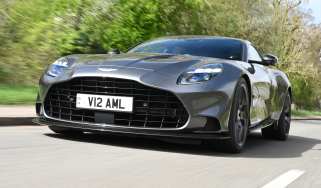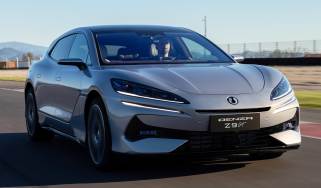New Toyota RAV4 to stick with hybrid power when it arrives later this year
The all-new SUV will focus on hybrid power and an improved cabin, and our exclusive images show what it could look like
An all-new generation of the Toyota RAV4 is about to be revealed, heralding a fresh take on one of the world’s best-selling new cars – and as our exclusive images show, this sixth iteration will be bigger, boxier and more technologically advanced, with a chunky design offering even greater appeal for its millions of customers.
However, while Toyota is planning a new look, under the skin we expect it to be closely related to the outgoing model by using the firm’s flexible TNGA architecture. In TNGA-K form, it’s being widely deployed across a variety of mid-sized Toyotas, such as the US-market Camry saloon and Highlander SUV, as well as most of the Lexus range including the NX and RX SUVs, the ES saloon and the LM MPV.
In terms of design, it’s understood that Toyota is keen to deliver a more rugged look with the RAV4, paired with sophisticated detailing. Up front, a set of slim C-shaped LED lights will be introduced, referencing other new Toyota designs such as the latest Prius and C-HR. These will be joined to a large lower grille integrated into the main body, and a bluff bonnet.
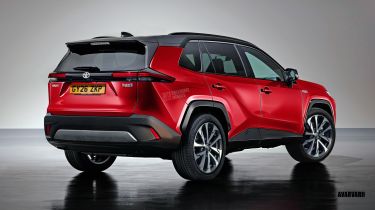
In profile, the RAV4 will retain its distinctive, squared off arches with plastic surrounds, while split C-pillars will allow the car to be specified with a contrasting roof colour. But don’t expect a sloping roofline or aggressive wide shoulders, as we have seen on other coupé-inspired SUVs, because this will be very much a model focused on practicality, as buyers have come to expect.
The rear end will be upright and boxy, which should be good for visibility and interior space, with a wide and deep tailgate aperture keeping the load lip as low as possible. The new RAV4 isn’t likely to set the world alight on design alone – it’s too important a model in terms of sheer market share – so some of the elements that have kept it so popular will inevitably be retained.
As is currently the case in Europe, a range-topping GR Sport trim will be offered featuring sporty design elements such as larger wheels and unique badging. Other elements from the current model, such as dual-colour paintwork and motorsport-inspired mesh grille inserts, will also be part of the package.
Inside, we expect the RAV4 to get a complete overhaul, with larger digital interfaces paired with a decent number of physical controls. While the RAV4 is technically unrelated to the much larger Toyota Land Cruiser, we suspect the SUV’s design and layout will be inspired by the flagship off-roader. This includes the use of a larger touchscreen, plus the adoption of a fully digital instrument cluster, plus tougher interior plastics and seat trim.
Given the likely underpinnings, we have a good sense of the sort of powertrains that Toyota will offer in the new RAV4, with European models likely to share a 2.5-litre naturally aspirated four-cylinder petrol engine and a CVT gearbox with varying degrees of hybrid assistance.
The range is likely to open with the latest take on Toyota’s HEV system, which combines a petrol engine with an electric motor and battery. This will power the front wheels, but can also be equipped with a mechanically linked all-wheel-drive system.
As the platform has evolved over the years, Toyota has continually expanded its application of more advanced plug-in hybrid options, which offer a substantial amount of engine-off running and therefore even lower running costs.
In this case, it’s probable that a new RAV4 plug-in will pair its four-cylinder petrol engine with a more powerful electric motor and larger lithium-ion battery pack. In the current Plug-in hybrid, Toyota quotes an EV range of up to 44 miles and a WLTP mpg rating of around 280mpg – figures we expect to improve further in the next generation. The plug-in powertrain also features a clever i-AWD system that adds an electric motor to the rear axle, improving traction without the need to fit a drag-inducing propshaft.
The current system produces an impressive 302bhp, but is seen as a premium option alongside the less powerful HEV. Supply of the cheaper version is limited due to tight EU fleet CO2 averages, suggesting a less powerful and cheaper plug-in could be introduced – possibly based on the set-up used in the smaller C-HR.
With such a wide remit, there might be pure ICE models available in some markets, but as hybrid powertrains are seen as core technology in all of Toyota’s global products, the new model could switch to hybrid-only. Even in the US, which is less concerned about fuel consumption and emissions, Toyota killed all pure-ICE variants of the Camry following its redesign last year, suggesting the same might be true of the next RAV4.
What’s less likely is an all-electric variant, as Toyota’s TNGA-K platform does not support large battery packs. The firm has previously confirmed that a more flexible, multi-energy platform is in development for its global models, but it’s thought the RAV4 will arrive too soon to adopt this architecture. This is unlikely to be a major worry, considering the model’s popularity in markets that have been slow to adopt EVs en masse.
Toyota’s work with hydrogen fuel-cells is likely to be a step too far for the new RAV4, despite the brand working on more space-efficient packaging. Hydrogen is very much part of the company’s future powertrain strategy, and there could be a chance of a derivative employing the tech at a later date – but it can’t happen without major modifications to the platform, and as such is off the table for mass production.
Toyota isn’t likely to offer a seven-seat version of the new RAV4, either, because it has other models to fill that niche depending on the market. In Europe, the Land Cruiser offers this, as did the more road-biased Highlander for a short while. However, this US- focused model didn’t gel with buyers on this side of the Atlantic.
As a critical model in Toyota’s global line-up, the RAV4 is a big contributor to the company’s overall profitability. Last year, it sold almost 800,000 of them in the US alone. It was also the world’s highest selling Toyota in both 2021 and 2022, and not far off the top-spot in ’23 and ‘24 either.
A big chunk of global sales go to North America, and RAV4s for that market are built in Toyota’s Kentucky and Canadian plants. Although the RAV4 is a global model, development of the latest version has been heavily influenced by the demands of the US and Canada. This may mean that European models come later, so while we’ll see the RAV4 this year, we’ll have to wait a little longer to drive it.
Pricing is expected to stick close to the current model, which costs from just under £40,000 for the base HEV and tops out at just under £49,000 for a GR Sport Plug-In hybrid. These prices put it above many of its key competitors, including the popular Kia Sportage and Hyundai Tuscon, as well as Volkswagen’s new Tiguan and the Ford Kuga.
However, it’s at the same level as its key rival, the Honda CR-V, which is a very close match for the Toyota in terms of dimensions and spec.
Our dealer network has 1,000s of great value new cars in stock and available now right across the UK. Find your new car…
Find a car with the experts

